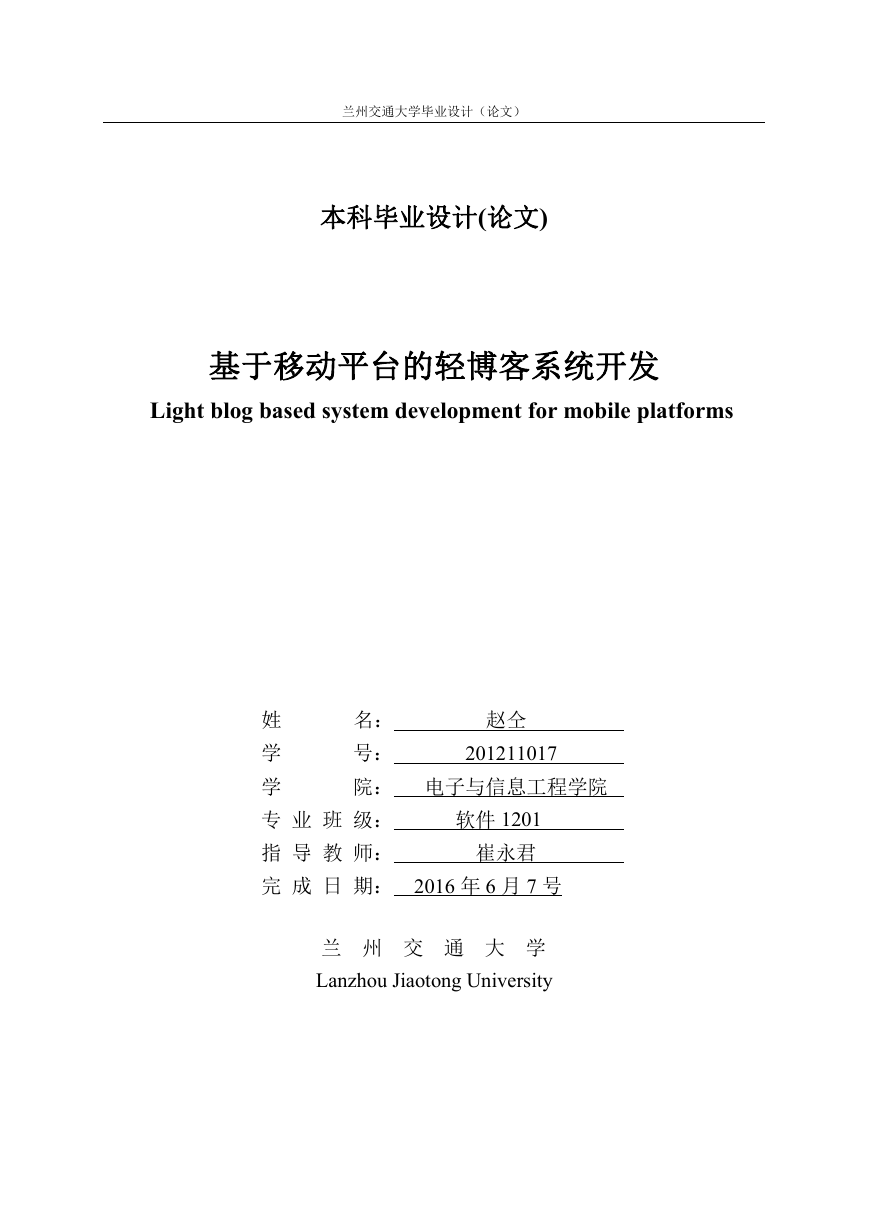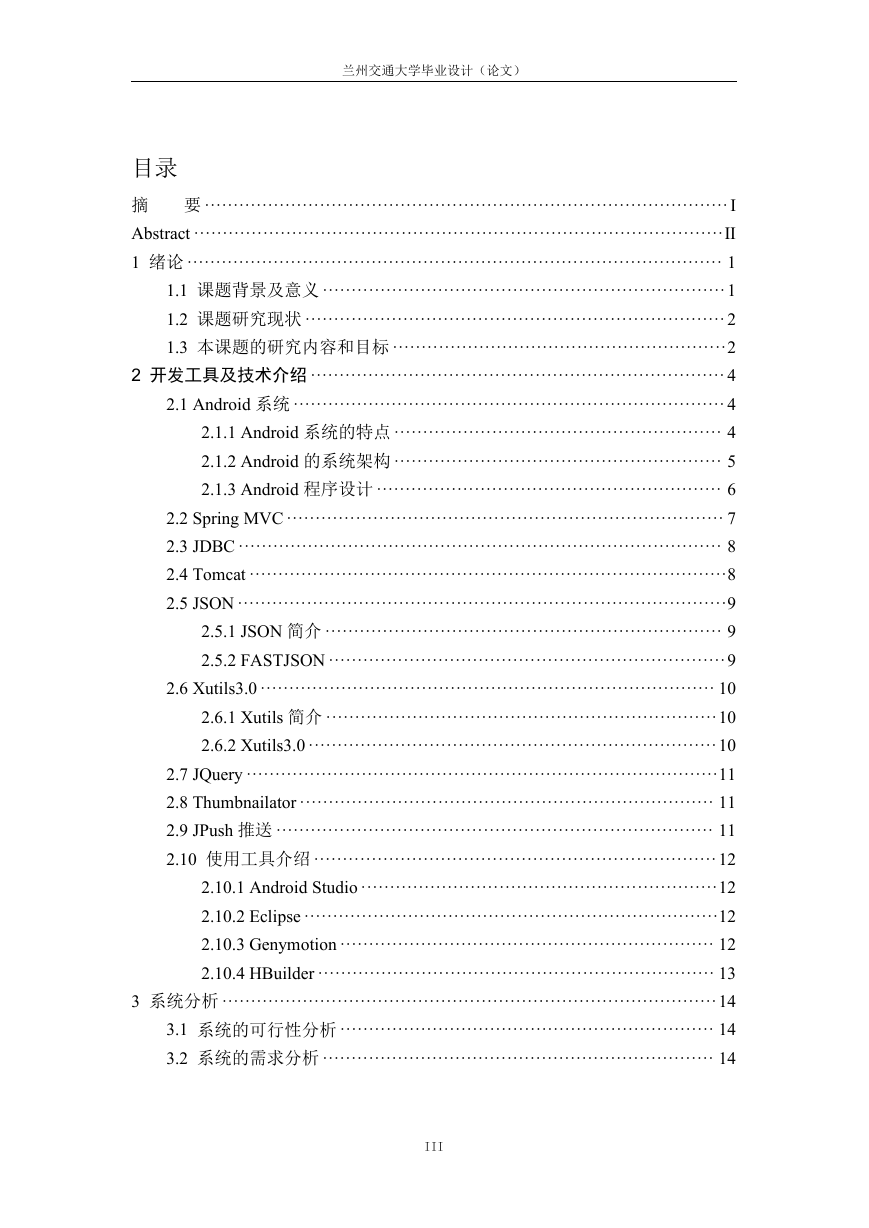兰州交通大学毕业设计(论文)
本科毕业设计(论文)
GRADUATION DESIGN(THESIS)
论文题目:基于移动平台的轻博客系统开发
本科生姓名:赵 仝
学号:201211017
指导教师姓名:崔永君
职称: 副教授
申请学位类别:
专业:
设计(论文)提交日期:(小四号楷体加黑)答辩日期:(小四号楷体加黑)
�
基于移动平台的轻博客系统开发
毕业设计(论文)版权使用授权书
本毕业设计(论文)作者完全了解 兰州交通大学 有关保留、使用毕业设计(论文)
的规定。特授权 兰州交通大学 可以将毕业设计(论文)的全部或部分内容编入有关数
据库进行检索,并采用影印、缩印或扫描等复制手段保存、汇编以供查阅和借阅。同意
学校向国家有关部门或机构送交设计(论文)的复印件和电子文档。
(保密的毕业设计(论文)在解密后适用本授权说明)
毕业设计(论文)作者签名:
指导教师签名:
签字日期: 年
月
日
签字日期: 年
月
日
�
兰州交通大学毕业设计(论文)
本科毕业设计(论文)
基于移动平台的轻博客系统开发
Light blog based system development for mobile platforms
姓
学
学
名:
号:
赵仝
201211017
院: 电子与信息工程学院
专 业 班 级:
软件 1201
崔永君
指 导 教 师:
完 成 日 期: 2016 年 6 月 7 号
兰 州 交 通 大 学
Lanzhou Jiaotong University
�
�
兰州交通大学毕业设计(论文)
摘
要
自从 2006 年,博客技术先驱 blogger 创始人埃文·威廉姆斯(Evan Williams)
创建 Twitter 后,轻博客就走入了人们的视野。随着互联网技术的发展,人们的
社交趋向于多媒体化,简洁,便捷,展示方式更加丰富的社交系统更加受到人们
的喜爱。各种类型的轻博客系统接连而至,诸如国外,Tumblr,Posterous,Noovo。
而国内已有前盛大的点点网、盛大网络轻博客社区“推他网”、网易 LOFTER、
新浪轻博客以及人人网推出的“人人小站”,拍旁科技推出的“身旁网”,凤凰
推出的“凤凰快博”,以及“米博”社区等。
本系统移动端使用 Android 平台开发移动端的应用程序,移动端开发工具采
用 Android Studio,而本系统的服务器端采用 Tomcat 作为 Web 服务器,Sqlite3
数据库引擎,Eclipse 作为开发工具。各种工具的版本都是以稳定版优先。
本系统旨在模拟轻博客系统在移动端的使用流程,帮助人们更加深层次的了
解轻博客系统。系统的 Android 端实现了用户注册登录,博文发送,博文搜索,
博文分享等功能,服务器端实现了管理员的管理,用户管理,博文管理,第三方
推送等功能,并且也实现了移动端与服务器端数据的对接。通过开发本系统,可
以帮助我们充分的了解当前移动端轻博客系统的主要开发流程以及主流的设计
思想。本系统是了解轻博客系统的一个重要途径。
关键词:轻博客系统;Android;Spring MVC;JSON
I
�
基于移动平台的轻博客系统开发
Abstract
Following the establishment of Twitter by Evan Williams, the founder of
blogger which comes as the pioneer for blog technology, in 2006 arises the light
blogging. With the development of internet technology, multimedization , simpleness,
convenience incline to be new tendencies for socialization. Furthermore, socialization
system with varieties of forms has gained great popularity. Variable types of light
blogging such as Tumblr,Posterous,Noovo from foreigh commpanies appear in rapid
succession. With regard to domestic websites, Diandian, Tuita, LOFTER, Sina,
Renren Xiaozhan, Shenpang, Phhoenix Fast, Mibo community and so forth are cases
in point.
By use of Android Studio, the mobile terminal of this system develops apps on
the basis of Android platform. Tomcat is utilized by server end as Web server , Sqlite
3 database engine and Eclipse as developing tools. All developing tools set the stable
version as priority.
This system is designed to simulate the using process of light blogging system
on the mobile terminal and make people have more in-depth understanding of light
blogging system. Functions such as registering, logging, sending, searching ,sharing
and so forth has been achieved on mobile terminal. Besides the functions such as
administrator's management, user management, blog management, third party push
and so forth, server end has also achieved the connection of data with mobile
termination. The development of this system will be conducive to full understanding
of the main development process of the light blogging system on mobile terminal and
mainstream design philosophy. This system plays an essential part in understanding
light blogging system.
Key Words: light blog system; Android; Spring MVC; JSON
II
�
兰州交通大学毕业设计(论文)
目录
要 ···························································································I
摘
Abstract ····························································································II
1 绪论 ····························································································· 1
1.1 课题背景及意义 ······································································1
1.2 课题研究现状 ·········································································2
1.3 本课题的研究内容和目标 ··························································2
2 开发工具及技术介绍 ········································································ 4
2.1 Android 系统 ··········································································· 4
2.1.1 Android 系统的特点 ························································· 4
2.1.2 Android 的系统架构 ························································· 5
2.1.3 Android 程序设计 ···························································· 6
2.2 Spring MVC ············································································ 7
2.3 JDBC ···················································································· 8
2.4 Tomcat ···················································································8
2.5 JSON ·····················································································9
2.5.1 JSON 简介 ····································································· 9
2.5.2 FASTJSON ·····································································9
2.6 Xutils3.0 ··············································································· 10
2.6.1 Xutils 简介 ····································································10
2.6.2 Xutils3.0 ·······································································10
2.7 JQuery ··················································································11
2.8 Thumbnailator ········································································ 11
2.9 JPush 推送 ············································································ 11
2.10 使用工具介绍 ······································································12
2.10.1 Android Studio ······························································12
2.10.2 Eclipse ········································································12
2.10.3 Genymotion ································································· 12
2.10.4 HBuilder ····································································· 13
3 系统分析 ······················································································14
3.1 系统的可行性分析 ································································· 14
3.2 系统的需求分析 ···································································· 14
III
�
基于移动平台的轻博客系统开发
3.3 系统的性能分析 ···································································· 15
3.4 系统的运行环境 ···································································· 15
3.4.1 服务器端软硬件支持 ·······················································15
3.4.2 客户端软硬件支持 ························································· 16
4 系统设计 ······················································································17
4.1 系统数据流图 ······································································· 17
4.2 类图 ····················································································18
4.3 用例图 ················································································ 18
4.4 时序图 ················································································ 20
4.5 数据库设计 ·········································································· 21
4.5.1 数据库逻辑设计 ···························································· 21
4.5.2 数据库的物理设计 ························································· 22
5 系统实现 ······················································································25
5.1 Android 手机端模块的实现 ······················································ 25
5.1.1 用户的登录注册模块的实现 ·············································25
5.1.2 Android 端系统主界面实现 ·············································· 27
5.1.3 用户的博文发表实现 ······················································28
5.1.4 用户博文的分享 ···························································· 30
5.2 服务器端模块的实现 ······························································ 31
5.2.1 管理员的增删改插模块 ···················································31
5.2.2 用户的管理模块 ···························································· 33
5.2.3 博文的管理模块 ···························································· 34
5.2.4 JPush 推送 ···································································· 35
6 系统测试 ······················································································36
6.1 测试环境 ············································································· 36
6.1.1 硬件环境 ····································································· 36
6.1.2 软件环境 ····································································· 36
6.2 测试计划 ············································································· 36
6.3 测试结果 ············································································· 36
7 总结 ····························································································39
7.1 总结 ····················································································39
7.2 展望 ····················································································39
IV
�
















 2023年江西萍乡中考道德与法治真题及答案.doc
2023年江西萍乡中考道德与法治真题及答案.doc 2012年重庆南川中考生物真题及答案.doc
2012年重庆南川中考生物真题及答案.doc 2013年江西师范大学地理学综合及文艺理论基础考研真题.doc
2013年江西师范大学地理学综合及文艺理论基础考研真题.doc 2020年四川甘孜小升初语文真题及答案I卷.doc
2020年四川甘孜小升初语文真题及答案I卷.doc 2020年注册岩土工程师专业基础考试真题及答案.doc
2020年注册岩土工程师专业基础考试真题及答案.doc 2023-2024学年福建省厦门市九年级上学期数学月考试题及答案.doc
2023-2024学年福建省厦门市九年级上学期数学月考试题及答案.doc 2021-2022学年辽宁省沈阳市大东区九年级上学期语文期末试题及答案.doc
2021-2022学年辽宁省沈阳市大东区九年级上学期语文期末试题及答案.doc 2022-2023学年北京东城区初三第一学期物理期末试卷及答案.doc
2022-2023学年北京东城区初三第一学期物理期末试卷及答案.doc 2018上半年江西教师资格初中地理学科知识与教学能力真题及答案.doc
2018上半年江西教师资格初中地理学科知识与教学能力真题及答案.doc 2012年河北国家公务员申论考试真题及答案-省级.doc
2012年河北国家公务员申论考试真题及答案-省级.doc 2020-2021学年江苏省扬州市江都区邵樊片九年级上学期数学第一次质量检测试题及答案.doc
2020-2021学年江苏省扬州市江都区邵樊片九年级上学期数学第一次质量检测试题及答案.doc 2022下半年黑龙江教师资格证中学综合素质真题及答案.doc
2022下半年黑龙江教师资格证中学综合素质真题及答案.doc